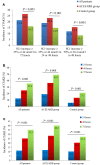Renin-angiotensin-aldosterone system blockade is associated with higher risk of contrast-induced acute kidney injury in patients with diabetes
- PMID: 32241961
- PMCID: PMC7185147
- DOI: 10.18632/aging.102982
Renin-angiotensin-aldosterone system blockade is associated with higher risk of contrast-induced acute kidney injury in patients with diabetes
Abstract
As the incidence of diabetes and cardiovascular comorbidities continues to rise, driven by increased prevalence of obesity and an aging population, so does the demand for percutaneous coronary intervention (PCI) to restore cardiac blood flow. Renin-angiotensin-aldosterone system (RAAS) inhibitors are commonly prescribed to hypertensive diabetic patients to prevent diabetic nephropathy. However, evidence suggests that angiotensin-converting enzyme inhibitors (ACEIs) and angiotensin receptor blockers (ARBs) may increase the risk of contrast-induced acute kidney injury (CIAKI) following coronary angiography (CAG) and PCI. We therefore conducted a retrospective, multicenter study applying the propensity score matching method to evaluate the impact of RAAS inhibition on CIAKI in diabetic patients undergoing CAG/PCI. Among 2240 subjects that met the inclusion criteria, 704 patients in the ACEIs/ARBs group were successfully matched to eligible control patients. The incidence of CIAKI (serum creatinine increase ≥0.5 mg/dl or ≥25% from baseline within 72 h post-CAG/PCI) was significantly higher in the ACEIs/ARBs group than in the control group (26.6% vs. 16.2%, P<0.001). However, control patients showed increased risk of overall adverse cardiovascular events (4.1% vs. 1.8% for ACEIs/ARBs; P=0.016). These data indicate that RAAS inhibition increases the risk of CIAKI in diabetic patients, but confers protection against early cardiovascular events.
Keywords: angiotensin receptor blockers; angiotensin-converting enzyme inhibitors; contrast-induced acute kidney injury; coronary angiography; diabetes mellitus.
Conflict of interest statement
Figures



Similar articles
-
The effect of renin-angiotensin-aldosterone system blockade on contrast-induced acute kidney injury: a propensity-matched study.Am J Kidney Dis. 2012 Oct;60(4):576-82. doi: 10.1053/j.ajkd.2012.04.017. Epub 2012 May 31. Am J Kidney Dis. 2012. PMID: 22658321
-
The Effect of Renin-Angiotensin-Aldosterone System Blockade Medications on Contrast-Induced Nephropathy in Patients Undergoing Coronary Angiography: A Meta-Analysis.PLoS One. 2015 Jun 17;10(6):e0129747. doi: 10.1371/journal.pone.0129747. eCollection 2015. PLoS One. 2015. PMID: 26083525 Free PMC article.
-
Effect of renin-angiotensin-system blockers on contrast-medium-induced acute kidney injury after coronary angiography.Korean J Intern Med. 2014 Mar;29(2):203-9. doi: 10.3904/kjim.2014.29.2.203. Epub 2014 Feb 27. Korean J Intern Med. 2014. PMID: 24648803 Free PMC article.
-
Impact of renin-angiotensin-aldosterone system-blocking agents on the risk of contrast-induced acute kidney injury: a prospective study and meta-analysis.J Cardiovasc Pharmacol. 2015 Mar;65(3):262-8. doi: 10.1097/FJC.0000000000000189. J Cardiovasc Pharmacol. 2015. PMID: 25502308 Review.
-
Effect of renin-angiotensin system blockers on contrast-induced acute kidney injury in patients with normal or mild-to-moderate reduced kidney function undergoing coronary angiography: A systematic review and meta-analysis.Clin Nephrol. 2020 Nov;94(5):227-236. doi: 10.5414/CN110171. Clin Nephrol. 2020. PMID: 32870151
Cited by
-
Incidence and Risk Factors of Contrast-Induced Acute Kidney Injury in Sudanese Patients Undergoing Coronary Angiography: A Descriptive Prospective Study.Cureus. 2022 Feb 3;14(2):e21876. doi: 10.7759/cureus.21876. eCollection 2022 Feb. Cureus. 2022. PMID: 35273847 Free PMC article.
-
Association of Hemoglobin Glycation Index With Contrast-Induced Acute Kidney Injury in Patients Undergoing Coronary Angiography: A Retrospective Study.Front Physiol. 2022 May 20;13:870694. doi: 10.3389/fphys.2022.870694. eCollection 2022. Front Physiol. 2022. PMID: 35669583 Free PMC article.
-
Risk factors for severe acute kidney injury among patients with rhabdomyolysis.BMC Nephrol. 2020 Nov 23;21(1):498. doi: 10.1186/s12882-020-02104-0. BMC Nephrol. 2020. PMID: 33225908 Free PMC article.
-
Predictors for Irreversibility of Contrast-Induced Acute Kidney Injury in Patients with Obesity After Contrast-Enhanced Computed Tomography Coronary Angiography.Adv Ther. 2025 Jan;42(1):293-309. doi: 10.1007/s12325-024-03036-z. Epub 2024 Nov 11. Adv Ther. 2025. PMID: 39527336
-
Contrast-Associated Acute Kidney Injury: Advances and Challenges.Int J Gen Med. 2022 Feb 15;15:1537-1546. doi: 10.2147/IJGM.S341072. eCollection 2022. Int J Gen Med. 2022. PMID: 35210826 Free PMC article. Review.
References
-
- Morice MC, Serruys PW, Kappetein AP, Feldman TE, Ståhle E, Colombo A, Mack MJ, Holmes DR, Choi JW, Ruzyllo W, Religa G, Huang J, Roy K, et al.. Five-year outcomes in patients with left main disease treated with either percutaneous coronary intervention or coronary artery bypass grafting in the synergy between percutaneous coronary intervention with taxus and cardiac surgery trial. Circulation. 2014; 129:2388–94. 10.1161/CIRCULATIONAHA.113.006689 - DOI - PubMed
-
- Farooq V, van Klaveren D, Steyerberg EW, Meliga E, Vergouwe Y, Chieffo A, Kappetein AP, Colombo A, Holmes DR Jr, Mack M, Feldman T, Morice MC, Ståhle E, et al.. Anatomical and clinical characteristics to guide decision making between coronary artery bypass surgery and percutaneous coronary intervention for individual patients: development and validation of SYNTAX score II. Lancet. 2013; 381:639–50. 10.1016/S0140-6736(13)60108-7 - DOI - PubMed
-
- Posma RA, Lexis CP, Lipsic E, Nijsten MW, Damman K, Touw DJ, van Veldhuisen DJ, van der Harst P, van der Horst IC. Effect of Metformin on Renal Function After Primary Percutaneous Coronary Intervention in Patients Without Diabetes Presenting with ST-elevation Myocardial Infarction: data from the GIPS-III Trial. Cardiovasc Drugs Ther. 2015; 29:451–59. 10.1007/s10557-015-6618-1 - DOI - PMC - PubMed
Publication types
MeSH terms
Substances
LinkOut - more resources
Full Text Sources
Medical
Research Materials
Miscellaneous

